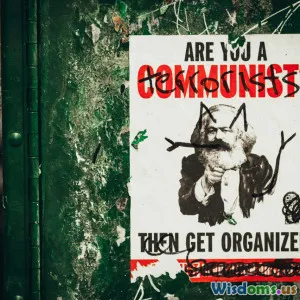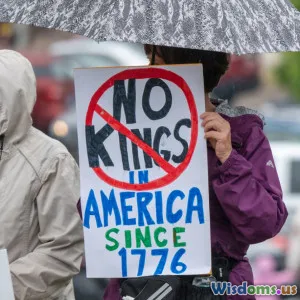
What If Society Abandoned the Social Contract
33 min read Explores consequences if society abandoned the social contract, from security and markets to digital alternatives like DAOs, with historical context and modern case studies. (0 Reviews)
When people talk about the “social contract,” it can sound abstract—something philosophers debate rather than a force you feel every time you flick on a light, buy bread, or call an ambulance. But imagine a day when that quiet agreement—pay taxes, obey laws, trust institutions to do their jobs—no longer exists. Not reform, not skepticism, but abandonment. Courts shutter. Police and regulators stop showing up. Elections are ignored. Contracts aren’t enforceable, and the phrase “public good” becomes a nostalgic relic. What happens next is not just a political theory problem. It is a logistics problem, a trust problem, and ultimately a survival problem.
Below is an analysis of how such a world could unfold, which forces step in, how daily life reshapes, and—most importantly—how communities can build back practical, durable agreements from the ground up. This isn’t a dystopian fantasy; it’s a map built from the scar tissue of real places that have endured institutional collapse and from tested insights in economics, ethics, and organizational design.
What Is the Social Contract, Really?

At its simplest, the social contract is a shared expectation: individuals trade some freedom (don’t steal, don’t drive 120 mph) for collective benefits (roads, courts, schools, defense). Thomas Hobbes imagined life without this agreement as “solitary, poor, nasty, brutish, and short,” arguing for a strong sovereign to keep peace. John Locke framed the contract as a way to protect natural rights—life, liberty, property—and justified rebellion if rulers betray it. Jean-Jacques Rousseau emphasized the “general will,” the idea that legitimacy comes from citizens, not rulers.
The theory has empirical fingerprints. Countries with higher social trust often have better governance and prosperity. The World Values Survey shows stark differences: in some Nordic countries, over half of respondents say “most people can be trusted,” while in lower-trust societies it’s often under 10%. Trust correlates with lower transaction costs—fewer guards, fewer lawsuits—and smoother collaboration.
Economists and political scientists track the contract’s strength with indicators like the World Bank’s Rule of Law index, the Fragile States Index, and homicide rates. High homicide rates often signal a breakdown of legitimate dispute resolution. In Colombia’s worst years, murder rates soared as insurgents and cartels supplanted state authority. Conversely, when institutions gain credibility, violence drops: targeted police reforms in cities like New York and Medellín, combined with community development, corresponded with substantial crime declines.
Elinor Ostrom’s research on commons governance shifted the conversation from “state vs. market” to “polycentric” solutions: communities can craft local rules that work without a central Leviathan, if designed with care—clear boundaries, graduated sanctions, low-cost dispute resolution, and inclusive decision-making. That’s the social contract in miniature. When we say “abandoning” the contract, we mean tearing up both formal and informal commitments—laws and norms—and replacing them with…something else. What fills that vacuum is neither neat nor abstract.
The Tipping Point: How a Social Contract Unravels

Societies don’t switch off overnight; they fray. Watch for early-warning signals:
- Erosion of impartiality: courts become partisan, prosecutors selective.
- Polarization metrics spike: media ecosystems split, cross-party friendships vanish.
- Declining service reliability: longer power outages, broken water systems, unpaid civil servants.
- Fiscal stress: mounting debt, unpaid pensions, unpaid suppliers.
- Security multiplication: private guards everywhere; gated compounds become islands.
Historically, tipping points cluster around contested succession, sharp economic shocks, or a trigger event that reveals the state’s impotence. Syria’s 2011 protests were followed by escalating repression and defections; Yugoslavia’s breakup showed how elite manipulation of identity, combined with collapsing federation institutions, can spiral into multi-front war. Lebanon’s civil war in 1975 grew out of unresolved sectarian power-sharing and armed camps that eclipsed the state.
The mechanism often looks like this: trust in neutral arbiters drops; groups invest in self-help enforcement; violence payoffs rise; moderates lose ground; the state’s monopoly on force erodes. Economists call this a coordination problem: if I think the police won’t protect me, I arm up; if you think I’m arming, you arm too, even if neither of us wants conflict.
Data can catch the slide. Rising inflation combined with currency substitution (people prefer dollars or cigarettes to local money), spikes in homicide or kidnapping, and deterioration on governance indices often precede open collapse. In fragile states, the informal sector can reach 60–80% of economic activity. Once tax compliance plunges, feedback loops worsen: less revenue means worse services, which means less legitimacy and even less compliance.
Day One Without a Contract: A Walk-Through

Picture a large city on “day one.” Courts have ceased hearing cases; law enforcement is either withdrawn, splintered, or aligned with factions. The immediate casualty is coordination. Without enforceable contracts and predictable response, just-in-time systems jam.
- Logistics: Food moves from farms to stores through a web of credit, permits, inspections, and insurance. Without enforceable invoices or protected shipments, wholesalers demand cash up front and security guarantees. Truckers face improvised checkpoints; some routes shut entirely. Perishable goods vanish first.
- Energy: Power plants rely on scheduled maintenance and fuel deliveries. If grid operators can’t count on workers showing up safely—or if parts don’t arrive—rolling blackouts spread. Fix crews become targets for theft or extortion.
- Banking: ATMs empty. Electronic transfers stall if payment processors can’t trust settlement. People rush to cash, then to barter. Without deposit insurance or trust in central bank policy, local scrip or commodity money emerges.
- Health: Clinics still have staff, but supply chains are brittle. Insulin and antibiotics need cold chains and predictable ordering. Immunization programs halt, not because vaccines vanish, but because outreach, record-keeping, and travel safety fall apart.
Social behavior shifts in hours. Property rights turn probabilistic; rumor and reputation determine what’s safe. Apartment boards post notices about night watches; WhatsApp groups become de facto dispatch centers. Some neighborhoods negotiate nonaggression pacts with nearby groups, others install makeshift barriers. For many, the first 72 hours decide whether a district becomes a stable enclave, an exploited corridor, or an evacuated ghost zone.
Who Fills the Vacuum? Warlords, Firms, and Neighborhoods

Nature abhors a vacuum, and so does power. Three actors tend to dominate after state retreat:
-
Armed entrepreneurs: warlords, gangs, and militias. They offer “protection” (often from themselves), resolve disputes, and tax commerce. Mexico’s cartels in some regions collect “piso” (tolls), settle conflicts, and even dictate social behavior—an ugly but functional order. In Mogadishu’s 1990s markets, clan-based security arrangements allowed wholesalers to operate amidst chaos, with embedded guards and negotiated safe-conducts.
-
Firms and private security: companies with the means hire protection, privatize logistics, and sometimes co-govern. The historical East India Company is an extreme case—corporate sovereignty with courts and armies. Contemporary analogues are less dramatic but real: mining companies run clinics and roads in remote regions; private security firms patrol entire districts, bound by contracts and client reputations.
-
Neighborhood institutions: faith groups, communal councils, and mutual-aid networks. After disasters—from Katrina to Fukushima—local groups often move faster than formal agencies. In Northern Syria, the autonomous administration of Rojava attempted bottom-up councils and women’s co-leadership to manage services under fire. In Chiapas, Zapatista communities built their own clinics and schools, using collective decision-making and rotating leadership.
Qualitatively, warlord rule trades predictability for predation; firm-led arrangements deliver efficiency for those who can pay; neighborhood compacts deliver legitimacy but require constant maintenance and credible enforcement. The most resilient enclaves are hybrids: local councils plus outsourced specialist services, backed by negotiated nonaggression agreements with armed actors who prefer stable cash flows to chaos.
Markets Without Courts: How Trade (Sort of) Continues

Commerce adapts. Without formal courts, merchants pivot to private ordering—mechanisms that punish defectors through reputation and reciprocity rather than judges.
- Reputation networks: Diamond dealers historically closed multi-million-dollar deals on handshakes within tight-knit communities where cheating meant permanent exile from the market. In crisis zones, traders use similar trusted subnetworks.
- Hawala and informal value transfer: Money moves via a global network of brokers who settle accounts off-ledger. It thrives where formal banking fails, using honor, kinship ties, and fast settlement as enforcement.
- Trade associations and arbitration: Guild-like bodies set standards and arbitrate disputes. In the medieval Lex Mercatoria, merchants enforced judgments through boycotts and denial of market access.
- Digital tools: Mobile money systems—think of Kenya’s mobile payments adoption—can survive even when formal banks wobble, provided cell networks and agents function. Crypto-assets may appear, not as ideological currency revolutions, but as borderless liquidity when capital controls or confiscations loom. Still, their volatility and custody risks limit everyday adoption.
Transaction costs go up. Every deal must price in enforcement and security. Extortion becomes a tax; risk premiums soar. Insurance morphs into protection contracts with armed groups or security firms. Yet trade continues because scarcity has its own pressure: food, fuel, and medicine must move. Caravans re-emerge in modern disguise: convoyed trucks with armed escorts, scheduled market days under temporary truces, barter fairs where goods trade without money.
The winners are those who can certify quality, guarantee delivery, and signal honesty. A simple ledger—publicly maintained, with clear entries of who delivered on time—can be more valuable than any gold stash when trust is the scarcest commodity.
Everyday Life: Education, Health, and Safety in a Post-Contract World

Daily rhythms compress around security and supply. Three domains define quality of life:
Education: Families often move to micro-schools and tutoring circles. A block-level classroom in a church basement with two retired teachers and a rotating parent guard can outperform a shuttered district school. Curricula skim down to literacy, numeracy, and practical science: water purification, basic electronics, gardening, and trades. Exams become local—skills demonstrations rather than certificates. Where connectivity persists, offline-first learning modules on cheap tablets become the library.
Health: Chronic disease management suffers first. Dialysis requires stable electricity; insulin requires refrigeration. Communities respond with micro-clinics powered by solar, backpack pharmacies, and scheduled treatment convoys. Preventive care’s decline shows up fast: vaccination rates slip, then measles returns; waterborne diseases spike when chlorine runs out or systems fail. In Yemen’s crisis, large cholera outbreaks followed infrastructure collapse—an example of how sanitation breakdown multiplies mortality without any battlefield nearby.
Safety: Nightfall changes behavior. Neighborhood watches adopt simple protocols: overlapping patrol routes, check-in codes, and conflict de-escalation training. Home hardening—lighting, dogs, laminated glass—becomes standard. Traffic rules degrade, so intersections rely on community-installed speed bumps and roundabouts.
Families also rediscover redundancy: backup water storage, two-week food inventories, and multiple communication modes (handheld radios, mesh network nodes, and designated couriers). Leisure shrinks but doesn’t disappear—people need rituals. Weekly markets, communal meals, and interfaith services double as security pacts, binding neighbors beyond mere transaction.
How Technology Changes the Script

Tech doesn’t stop; it reorganizes. Some tools entrench predation, others empower communities.
- Communications: Mesh networks and community LTE can route around failed ISPs if enough nodes exist. Neighborhoods deploy Wi-Fi relays and solar-powered routers to maintain a local intranet for alerts, trading boards, and medical guidance. Even without the wider internet, a robust local net preserves coordination.
- Surveillance: Drones, cheap cameras, and AI-powered video analysis give asymmetric power to both militias and communities. A small team can monitor supply routes or spot ambushes. The ethical danger is obvious: the same systems can be used to target opponents or extort civilians.
- Payments and identity: Crypto wallets and stablecoins may serve as portable value when banks fail, but custody and scams are real threats. Self-sovereign identity schemes—cryptographic credentials attested by trusted local bodies—can help people prove qualifications or reputation without a central registry. In practice, a laminated card plus a registry maintained by multiple neighborhoods can be almost as useful.
- Manufacturing: 3D printing produces fittings, brackets, medical device components, and basic tools. It cannot substitute advanced manufacturing, but it can keep water systems running and clinics stocked with adapters. The downside is weapon components become easier to fabricate; governance must keep pace.
- Open-source intelligence: Satellite imagery, mapping apps, and crowdsourced alerts help plan safe routes and document abuses. They also reduce the monopoly of information historically held by state or warlord elites.
Tech’s lesson is not that tools save you; governance does. The best outcomes come when technology is embedded in transparent, accountable rules—with shared maintenance duties, audit trails, and open access.
Ethics in the Absence of a Referee

When laws lose their teeth, norms become law. How do communities keep ethics from dissolving into mere expediency?
- Game theory offers one clue: strategies like tit-for-tat with forgiveness encourage cooperation in repeated interactions. If someone defects, you punish once, then reset to cooperation if they reform. It’s tough, but it avoids cycles of vengeance.
- Virtue ethics reframes identity: be the kind of person who keeps promises. Communities that explicitly honor promise-keepers—public recognition, preferential access to opportunities—create a status economy around integrity.
- Restorative justice can outperform retribution in resource-poor settings. Rather than fill nonexistent prisons, offenders repair harm—labor for the affected family, restitution from community funds, monitored agreements. It’s not utopia; violent crimes still require incapacitation. But for theft and minor assaults, it can restore trust faster than brittle punitive systems.
- Ostrom’s principles again: make rules with those who must live under them; define boundaries; monitor behavior; scale sanctions; provide low-cost conflict resolution; recognize the group’s right to self-organize; and nest groups in larger networks.
Examples abound. Maine’s lobster fishers enforce territorial norms informally, with community sanctions that keep the commons sustainable. Amish communities operate with Ordnung—informal codes that prioritize reconciliation and social cohesion over litigation. These models work because they align incentives with identity and embed enforcement in relationships, not distant bureaucracy.
How to Build Micro-Contracts: Practical Playbook

If the macro-contract is gone, build micro-contracts. Here’s a concrete blueprint for a neighborhood of 200–500 people.
- Constitute the group
- Membership: Define who’s in—residents by address, plus a process for affiliates (shopkeepers). Keep a roster with two verifiers per entry.
- Charter: One page. Purpose, scope (safety, water, market), decision rules (simple majority for operations, two-thirds for bylaw changes).
- Map assets and risks
- Assets: Water sources, rooftops for solar, skilled residents (nurses, electricians), shared spaces.
- Risks: Chokepoints, likely aggressors, flood/fire zones. Produce a simple map posted publicly.
- Establish core services
- Security: 24/7 watch with 2-hour shifts, pairs, radios. Clear use-of-force rules. Weekly training in de-escalation. Liaison committee to negotiate with neighboring groups.
- Water and sanitation: Rain catchment, wells, or tanker schedules. Chlorination protocol: for clear water, 8 drops of unscented household bleach per gallon; for cloudy, 16 drops; wait 30 minutes. Maintain test kits and a log.
- Food: A co-op that aggregates orders weekly, pays trusted wholesalers in cash or goods, and runs a fair-price market twice a week. Keep a 2–4-week staple buffer (rice, beans, oil) stored in sealed containers with inventory rotation.
- Health: A micro-clinic with a locked formulary, cold storage (solar + battery), and a referral network. Track vaccinations, chronic patients, and pregnancies. Pool funds for emergency transport.
- Build governance
- Duty rosters: Publish schedules for watch, sanitation, clinic, market. Missed duties trigger graduated fines or make-up shifts.
- Dispute resolution: A three-person panel rotates monthly. Hear complaints within 72 hours; decisions are posted with rationale. Appeals require a five-person ad hoc council.
- Finance: Transparent ledger on a board and digital mirror (if possible). Contributions can be cash, in-kind, or hours. Maintain a 10% reserve fund for shocks.
- Create economic glue
- Local scrip or ledger credits for labor contributed, redeemable at the co-op. Cap issuance to prevent inflation. Audit monthly.
- Trade reputation board: List businesses with green/yellow/red ratings based on delivery history. Overturn ratings only after a public hearing.
- Connect outward
- Federate with adjacent neighborhoods for mutual defense and bulk procurement.
- Set nonaggression pacts and shared protocols: recognition of each other’s IDs, joint patrols at borders, and dispute hotlines.
- Train and iterate
- Monthly drills: medical, fire, evacuation, and comms blackout.
- After-action reviews: what failed, what improved, what to drop.
These steps are unglamorous, but they’re how a micro-contract becomes real: explicit duties, measurable outputs, and community enforcement.
Economies of Trust: Re-growing Civic Infrastructure From the Ground Up

Trust is a flywheel. The trick is to get it turning in the right direction.
- Participatory budgeting: Porto Alegre’s famous experiment showed that when citizens allocate slices of public funds, outcomes and trust improve. In a post-contract zone, adapt the idea: dedicate a portion of co-op revenues to projects chosen in open assemblies—street lighting, clinic expansion, apprenticeships.
- Mutual finance: Rotating savings and credit associations (ROSCAs) and credit unions keep money local and reduce predatory lending. They also create social pressure to repay.
- Micro-insurance: Pool risk for health emergencies or crop failure. A neighborhood pool that pays out based on verified triggers (clinic report or rainfall gauge) prevents ruin from random shocks.
- Procedural justice: When authorities (even volunteer ones) treat people fairly—explaining decisions, allowing voice—compliance rises. Police departments that adopted these practices saw better outcomes without more force. Apply the same inside micro-contracts.
- Truth circles: Where violence or exploitation have occurred, communities need mechanisms to acknowledge harms. Borrow from truth and reconciliation processes: testimony, apology, restitution, amnesty for lesser offenses conditional on disclosure. Imperfect, but better than denial.
Over time, federations of micro-contracts can coordinate larger systems—regional markets, power microgrids, shared water infrastructure—while preserving local autonomy. Think of Swiss cantons’ balance between local control and federal cooperation, or the way cooperative federations in Italy’s Emilia-Romagna region built competitive clusters without a central command.
Comparison: Anarchism, Minarchism, and Corporate Sovereignty

Different ideologies offer rival blueprints for life without a traditional social contract.
- Anarchism (left variants): Emphasizes mutual aid, horizontal governance, and commons-based production. Rojava’s councils, Zapatista autonomous zones, and cooperative networks reflect this ethos. Strengths: legitimacy, resilience, social inclusion. Weaknesses: defense against predatory actors, scaling complexity.
- Anarcho-capitalism: Envisions private law, competitive security, and market arbitration. The promise is efficiency and consent through contracts. Historical hints—merchant law, private arbitration courts—show parts can work. Risks: unequal bargaining power, coercion disguised as contract, and public goods undersupply.
- Minarchism: A “night-watchman state” focused on defense, courts, and property protection. Attractive as a lean reboot, but tough to implement without a tax base and trust. If captured by factions, it reverts to oligarchy.
- Corporate sovereignty: Company towns, charter cities, and special economic zones (SEZs) grant firms or quasi-public entities broad governance. Some SEZs boosted investment and jobs; others sparked backlash over accountability. Historical company towns delivered housing and services but also coercion—recall the Pullman strike’s lessons about power imbalance.
Real-world outcomes often mix elements: a cooperative clinic under a private security umbrella within an autonomous municipality. The critical variable isn’t the label; it’s checks and balances. Who audits the auditors? How easy is exit? Can residents voice dissent without fear? Systems that answer those questions well can sustain freedom and order longer than doctrinaire purity.
Metrics That Matter: Tracking Recovery or Descent

If you can’t measure it, you’ll struggle to manage it. Communities and federations can track practical indicators to know whether they’re repairing the social fabric or slipping further.
- Safety: Homicides per 100,000 residents; reported assaults; response times for emergencies; theft rates per market day. Supplement with perception surveys—do people feel safe walking at night?
- Health: Vaccination coverage; maternal and infant mortality rates; clinic stockout days; prevalence of waterborne disease; mental health check-ins.
- Infrastructure: Electricity reliability (hours available per day; average outage duration); water quality tests (chlorine residual, coliform counts); road accessibility index (percentage of routes passable). Satellite night lights can serve as a rough proxy for economic activity.
- Economy: Food price volatility for staple baskets; market attendance; employment in co-ops; credit repayment rates; mobile money agent float levels.
- Governance: Meeting attendance; dispute resolution backlog; audit completion rates; turnover in leadership roles; number of functioning mediators/arbitrators.
- Trust: Simple quarterly surveys—“Do you trust your neighborhood council?”—with anonymous ballots. Track cross-neighborhood collaboration events.
Use citizen science: train volunteers to collect and post data publicly. Adopt shared dashboards across federations with standardized formulas. Require after-action reviews tied to the indicators. Numbers won’t save you, but they keep you honest.
The Long Game: From Patchwork to New Social Contracts

No community wants to live forever in patchwork governance. The long game is to stitch micro-contracts into a stable, legitimate macro-contract—without repeating the mistakes that caused collapse.
- Constitutional conventions: Start small—regional assemblies that codify rights and responsibilities. Guarantee minority protections, freedom of movement, and due process. Borrow from best practices: independent courts, civilian control of any armed forces, transparent budgeting, and clear limits on emergency powers.
- Polycentric governance: Don’t erase successful local institutions; nest them. Let neighborhoods manage schools, markets, and basic utilities while federations coordinate defense, major infrastructure, and inter-regional trade. Reserve secession and joining mechanisms to keep accountability real.
- Checks and balances: Separate purse and sword. Rotate leadership, require conflict-of-interest disclosures, and entrench audit bodies that citizens can trust. Make exit cheap: if you don’t like your district, you should have a legal path to move or switch jurisdictions.
- Transitional justice: Address past harms intentionally. Amnesty conditioned on truth-telling and restitution, lustration for the worst abuses, and reparations where feasible. Without this, old wounds reopen under new flags.
- Civic culture: Rebuild rituals that reinforce shared identity—service days, citizen juries, participatory festivals. Civic education that includes practical governance—how to read a budget, run a meeting, and audit an agency—turns spectators into stewards.
Historical analogies remind us: the United States moved from a loose Articles of Confederation to a stronger Constitution precisely because coordination costs and free riding overwhelmed the patchwork. The European Union shows how incremental integration can expand prosperity while grappling with democratic legitimacy. Switzerland’s cantonal model demonstrates durable local autonomy nested within a federal framework. None are frictionless, but all are better than permanent militia checkpoints.
At its best, a renewed social contract is explicit about three bargains: equality before law; participation with real teeth; and fair contribution to common goods. If any leg falters, the stool wobbles. If all hold, prosperity follows—not just in GDP, but in longer lives, lower fear, and richer possibilities.
A world that abandons the social contract is not empty; it’s crowded with ad hoc pacts, predatory rents, and fragile truces. But it is also a world ripe for reinvention. The same human instincts that build gangs and empires can build clinics, credit circles, and federations—if given the right incentives and the right stories to live by. The challenge is to make cooperation cheaper than coercion, honesty more rewarding than hustle, and dignity a renewable resource. That work begins on your street, with your neighbors, long before any flag flies again.
Rate the Post
User Reviews
Other posts in Sociology
Popular Posts
















